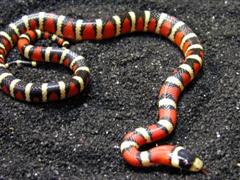Kingsnake - Arizona Mountain
Arizona Mountain King Snake, Sonoran Mountain Kingsnake, Pyro Scientific Name: Lampropeltis pyromelana pyromelana
Sat, 7th June, 2025 - 8:00 pm GMT
Sponsor Ads:

Alternative Name
Arizona Mountain King Snake, Sonoran Mountain Kingsnake, Pyro Scientific Name: Lampropeltis pyromelana pyromelanaBasic Info
A relatively small species of Kingsnake, the Arizona Mountain Kingsnake rarely exceeds 42 inches in adult length. They are banded in white or yellowish rings, separated by wide red and thin black bands. They are very similar in coloration to the western Coral Snake.
Health
An ambient temperature of about 70 degrees Fahrenheit is suitable, with a basking area of between 80 and 85 degrees Fahrenheit. They will hibernate during the winter, at which time the temperature should be between 45 and 55 degrees Fahrenheit. They require a hiding place. Good substrates for the Arizona Mountain Kingsnake's enclosure include newsprint, orchid bark chips, paper towels, or aspen shavings. They should always have access to clean water. They may begin refusing food in the early fall, at which time the temperature should be lowered for hibernation. Wild-caught Mountain Kingsnakes usually have many parasites and should be quarantined and treated before being introduced to their captive environment. Breeding To breed Arizona Mountain Kingsnakes, they must first be brumated for three to five months at temperatures between 45 and 55 degrees Fahrenheit. After the brumation period, the animal should be fed twice what they usually are. The Arizona Mountain Kingsnake usually lays only one clutch of eggs and often lays it earlier in the season then other species. After copulation, the eggs will be laid in about seven weeks. The female will usually shed before she lays the eggs. They will be laid in a clutch of between three and ten eggs, on average, and will hatch after between 60 and 85 days of incubation at between 78 and 82 degrees Fahrenheit.Habitat
Be found by lifting up rocks on the edges of rock piles found near streams.Behavior
The Arizona Mountain Kingsnake is also known as the Sonoran Mountain Kingsnake or "Pyro". Active in the wild between April and November, they usually live in mountains or rock piles and rarely venture far from their homes. They are most active after periods of rain. Primarily diurnal, the Arizona Mountain Kingsnake usually ventures out between morning and evening, depending on the weather. They are primarily terrestrial, meaning they spend most of their time on ground, although they have been observed climbing trees and hunting in low bushes. The areas in which the Arizona Mountain Kingsnake makes its home are often characterized by pinyon-juniper woodland and pine-fir woodland. They often live near streams or other water sources and usually live near rock piles, where they make their homes. The snakes usually only emerge from the rock piles to feed, mate, or to find a better hiding spot. They usually live in elevations between 4500 and 7500 feet.When threatened, Arizona Mountain Kingsnakes will emit a musk scent and may bite. When properly handled, they can become quite docile and make excellent pets.Origin
North AmericaHistory
Arizona Mountain Kingsnakes can be found in Arizona, Nevada, Utah and Mexico. In the United States, there are very strict laws regarding the capture of wild species. In Arizona, one must acquire an Arizona general hunting license before removing snakes from their natural environment. Even if the proper measures are taken, it can be very difficult to find an Arizona Mountain Kingsnake in the wild. They are easy to breed in captivity and so captive-bred specimens are becoming readily available. In the wild, they can often be found by lifting up rocks on the edges of rock piles found near streams.Common Foods
feeds on lizards, birds, snakes, eggs, frogs, lizards and small mammalsSponsor Ads:
In my view, those of us who teach science to nonscience majors must continually encourage them to base their beliefs on evidence rather than mere prior preference. -- William H. Ingham (Physicstoday.org)
Kingsnake - Arizona Mountain
Coded by: BGID® | ALL RIGHTS RESERVED Copyright © 2000-2025
Disclaimer | Privacy | Report Errors / Contact | Credits








 Preparing For China. China is growing their military. China Military Technology - can it keep up with the US?
Preparing For China. China is growing their military. China Military Technology - can it keep up with the US?  versus
versus 

 versus
versus 
 This Thread is about the North Korean Military itself - the kind of army, navy, and air force they have.
This Thread is about the North Korean Military itself - the kind of army, navy, and air force they have. 
 versus
versus 
 versus
versus  versus
versus